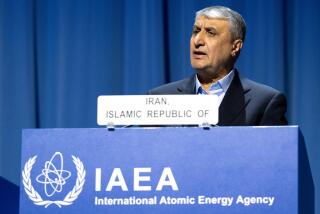What Was India Thinking?
- Share via
It took India’s new Hindu fundamentalist government, headed by the Bharatiya Janata Party, little more than a month to toss a monkey wrench into the delicate process of procuring a global end to nuclear weapon testing. On Monday, India ended its policy of nuclear ambiguity, in place since its first test of a “peaceful nuclear device” in 1974 and demonstrated that the world’s most populous democracy possesses a spectrum of nuclear weapons for use against its neighbors.
The three bombs tested in one shot by Indian scientists supposedly included a simple fission device, a “low yield” device and a thermonuclear weapon. The Indian armed forces presumably can now call upon an ordinary nuclear bomb, perhaps of the power that destroyed Hiroshima, a battlefield weapon and a city-destroying hydrogen weapon.
Why the Indian government chose to test now instead of a decade or more ago while it was developing its weapons technology remains somewhat of a mystery. Whether all three detonations were as successful as Prime Minister Atal Bihari Vajpayee’s press briefing indicated is a good question. Seismic data report body wave magnitudes of about 4.7 to 5.3 from monitoring stations. The magnitudes of the shocks are consistent with a blast of 20 to 100 kilotons, not the multimegaton yields typical of most thermonuclear weapons.
It is possible, of course, that the Indian thermonuclear bomb was altered to produce a comparatively small yield rather than hundreds or even thousands of kilotons, a difficult achievement on a first test. It is equally possible that the Indian scientists simply didn’t get it right and that the thermonuclear weapon was a bit of a fizzle. Such nuclear errors happen.
Nonetheless, the Indians now have overtly tested, without the pretense that their weapons were “peaceful” nuclear devices. It remains to assess the consequences for the world and in particular for India’s neighbors and the Comprehensive Test Ban Treaty awaiting U.S. Senate ratification.
Pakistan, understandably, is outraged. Two of the Indian weapons, the low yield or battlefield device and the pure fission weapon, certainly have “Islamabad” painted on their fuzes. China will not tremble at the Indian mastery of weapons of mass destruction, but must be uncomfortably aware that the thermonuclear weapon was intended to intimidate it.
China will deplore the Indian attempt to frighten its neighbors but likely will not feel compelled to conduct another nuclear test. It, too, fought for an end to testing and has observed the global moratorium. Three tests do not give India nuclear parity with anyone. China will act responsibly to condemn the Indian actions and cooperatively with the rest of the U.N. Security Council should other steps be called for.
India’s move to become an overt nuclear power ought to cost it dearly in the United Nations. For many years, India has sought an expansion of the permanent membership of the Security Council, with one of the new seats reserved for itself as senior representative of the nonaligned movement. Loss of an expansion franchise in the Security Council is the least of the penalties India should pay. U.S. restrictions on trade, a continuation of the U.S. embargo on nuclear sales to India, an end to military sales, termination of high-tech exports to India and the blocking of U.S. financing of Indian industry should follow. So should a prohibition on the import of Indian-written computer programs.
The spectacle of three surprise nuclear explosions will make U.S. Senate ratification of the Comprehensive Test Ban Treaty more difficult. The Indian tests were detected worldwide, and Indian actions can easily be verified by the kind of on-site inspections called for in the treaty. However, the United States had no advance intelligence warning of the explosions. This may reveal a previously unsuspected weakness in the way nuclear proliferators are monitored and may cause senators to balk at ratification. That would be a great setback for arms control and nuclear stability. India opposed the treaty; did it also seek to sabotage it?
There is a possible silver lining in this mushroom cloud. Having tested a variety of nuclear devices, India may have learned enough weapons physics to stop testing, rely on computer simulations and declare itself ready to accept the test ban treaty. Perhaps after detonating one or two weapons in a tit-for-tat response, Pakistan will feel able to follow India’s lead, clearing the way for global acceptance of the treaty. Such a happy outcome is not, however, likely under the BJP government in India.
In the end, one is left with questions. Why did India test when its scientists surely knew how to build conservatively designed weapons without provoking global censure? Why did it abandon a 24-year policy of nuclear ambiguity? How were Indian weaponeers able to prepare a test without advance detection? Will the world shrug off this example of Indian hypocrisy--the test ban treaty was originally Prime Minister Jawaharlal Nehru’s idea--or take it to task for violating what had become the world’s long-sought norm against nuclear testing and nuclear proliferation?
More to Read
Sign up for Essential California
The most important California stories and recommendations in your inbox every morning.
You may occasionally receive promotional content from the Los Angeles Times.












